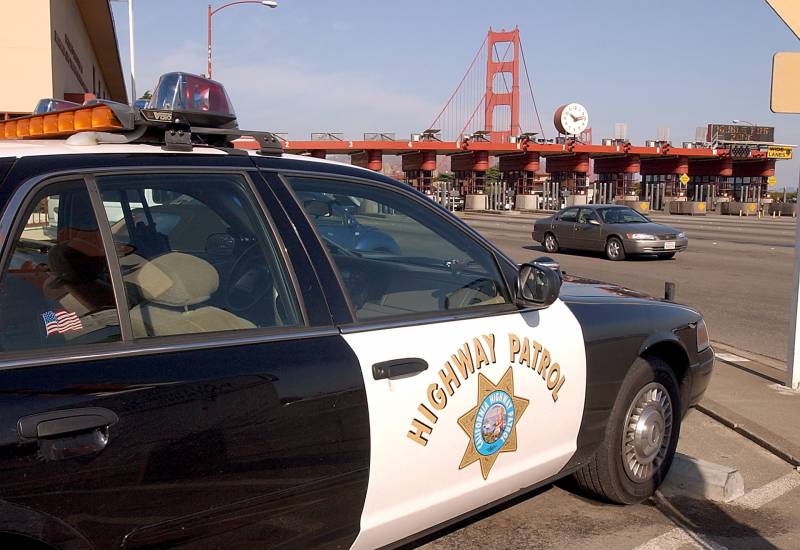“Due to the nature of the CHP’s enforcement contacts, in-car cameras provide the most benefit … ,” wrote spokesperson Fran Clader in an email to CalMatters.
She said the agency will continue evaluating whether to expand its body camera usage.
In the meantime, some local agencies say they’re happy to fill CHP’s technology gaps.
“We’re a small department, and for us to be able to help a statewide agency … we don’t do that very often,” Arcata police chief Brian Ahearn told CalMatters.
“[The local CHP office] could not have been more grateful for us to provide our video … to illustrate to the community the entirety of the event that led to the use of deadly force,” he said.
State 'dropped the ball' on bodycams
In 2015, the California Highway Patrol was at the top of some legislators’ lists to receive funding for body cameras. As the nation grappled with protests against police brutality, Assemblymember Reginald Jones-Sawyer — then chair of the California Legislative Black Caucus — lobbied to “require all California Highway Patrol officers to wear video cameras,” he wrote in an editorial for The Sacramento Bee.
Jones-Sawyer’s $10 million pitch to give all CHP officers body cameras eventually was whittled down to a $1 million pilot program in the agency’s Oakland and Stockton areas. A year into the pilot, officers recorded nearly 93,000 videos, but the program was never expanded.
“Let’s be clear, they never wanted to do any of it,” said Jones-Sawyer, a Democrat from Los Angeles. “If it wasn’t for me pushing for the pilot program, they never would have had the 200 [body cameras].
“In some ways, we dropped the ball,” he said. “We’re not going to drop it anymore.”
While CHP experimented with its limited pilot program, many local law enforcement agencies in California have gone all-in on body cameras.
For example, the Los Angeles Police Department, which has a smaller budget, has given body cameras to more than 7,000 uniformed field officers, or about 73% of its force.
Carrie Lane, chief executive for the California Association of Highway Patrolmen, says its members support body cameras.
“They recognize body-worn cameras can be a benefit to the public by providing greater transparency that helps engender trust,” Lane said in an email response to CalMatters. “The challenge of body-worn cameras is, and always has been, cost.”
Other states lead California on bodycams
The same year former Gov. Jerry Brown signed off on the pilot program, South Carolina passed a law requiring fully funded police agencies to give their officers body cameras. Since then, Colorado, Connecticut, Illinois, Maryland, New Jersey and New Mexico all have passed laws mandating body cameras for officers, according to the National Conference of State Legislatures. Last year, New York introduced body cameras for all of its state troopers.
In California, it’s a different story.
CalMatters queried more than a dozen of California’s largest police and sheriff’s departments and found that nearly all had at least some body cameras. Among the varying policies:
- Police departments in Los Angeles, Arcata, Bakersfield, Fresno, Oakland, Sacramento, San Jose and Stockton have given body cameras to all of their uniformed patrol officers. So have the Kern, Sacramento and San Diego county sheriffs’ departments. Some agencies have extended their body camera usage beyond just patrol officers.
- The Los Angeles County Sheriff’s Department, the state’s largest law enforcement agency, has outfitted 37% of all sworn personnel with body-worn cameras, according to the agency spokesperson.
- The Long Beach and San Francisco police departments and the Orange County and San Francisco county sheriff’s offices have given some of their officers body cameras.
The San Bernardino County Sheriff’s Department was the only agency among those contacted that said it had no body or dashboard cameras. In contrast, the Sacramento Police Department provides both body and dashboard cameras for all of its officers and marked vehicles.
Dashboard cameras also have been shown to be crucial when evaluating police encounters. A recent study shows that when people view dashcam footage, they are more likely to assign blame to officers than when they watch body camera footage of the same incident.
“In some ways, you get more visual information about what’s going on from the dash camera,” said assistant professor Camp. “One thing that body cameras get us, which I think is important but overlooked, is the audio. You can’t get that from a camera that’s mounted on an officer’s car quite a distance away.”
As for the highway patrol, it’s betting on improved dashboard cameras. The agency is nixing the grainy, DVD-based cameras it has used statewide since 2010.

